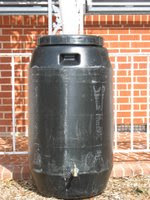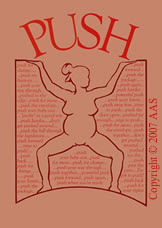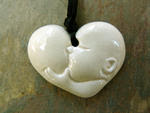So sorry to the bearer of more bad news about toxins and prenatal development.
Direct measurements of chlorination byproducts in a municipal water supply reveal that levels in water above 70 µg/liter during the second trimester are associated with lower birth weight. The increased risk of low birth weight among minority women was almost double that of white women, 60% vs. 37% increase, respectively. American Journal of Epidemiology. 26 December 2005. More...
A small study in China of children diagnosed with ADHD finds a highly significant difference in blood mercury levels between cases and controls. The children with ADHD had blood mercury levels on average (geometric mean) over 50% higher than controls. Children with blood mercury levels above 28 nmol/L were over 9 times more likely to have ADHD. Neuropediatrics. 23 December 2006. More... [related stories]
Prenatal exposure to the pesticide chlorpyrifos is associated with developmental delays in children and attention deficit hyperactivity problems. The proportion of New York City 3-yr olds showing delayed development was five times greater in the higher exposure group. Pediatrics. 21 November 2006. More... [related stories]
A large study in Spain of the impacts of prenatal exposure to the organochlorine, hexachlorobenzene, finds that children with higher levels of HCB are less competent socially and more at risk to attention deficit hyperactivity disorder. Measurements of contamination were obtained at birth and examined in relation to behaviors at the age of 4 years. Exposures were for people living in an area where HCB exposure was elevated because of proximity to an electrochemical factory. Environmental Health Perspectives. 13 November 2006. More... [related story]
Evidence suggests that neurodevelopmental disorders caused by industrial chemicals has created a silent pandemic in modern society. Although these chemicals might have caused impaired brain development in millions of children worldwide, the profound effects of such a pandemic are not apparent from available health statistics. 201 chemicals have been shown to be neurotoxic in people, while over 1000 have been shown neurotoxic in animals. Most have not been tested in people. Lancet. 8 November 2006. More... [related stories]
Higher background levels of DDT are associated with lower skill levels in verbal, memory, quantitative and perceptual- performance tests at age 4 years. The associations, in a study of 475 children in Spain, were stronger among girls. The authors conclude that the association between prenatal exposure to background, low-level DDT and decreases in preschooler's cognitive skills should be considered when evaluating the risks and benefits of spraying DDT to combat malaria. American Journal of Epidemiology. 4 November 2006. More... [related stories]
A meta-analysis of epidemiological studies of links between Agent Orange and birth defects finds a strong association. Overall, the relative risk of birth defects increased 95% with Agent Orange exposure. Vietnamese studies showed an increase of 300%. International Journal of Epidemiology. 19 October 2006. More... [related story]
Science Byte: A study of Inuit preschool children reports that the risk of ear and acute respiratory infections is associated with exposure to PCBs in the womb. Children in the highest quartile of exposure were 25% and 40% more likely than children in the lowest quartile for ear and respiratory infections, respectively. The research team concluded that "prenatal exposure to PCBs could be responsible for a significant portion of respiratory infections in children of this population. EHP. 20 March 2006. More...
Science Byte: Children of mothers working in the flower trade in northern Ecuador have neurobehavioral deficits associated with exposures to pesticides in the womb. Prenatal exposure was also linked to higher blood pressure in the children. The research indicates that fetal contamination may cause lasting neurotoxic damage that adds to the adverse impacts of malnutrition. Pediatrics. 8 March 2006. More... [related story]
Science Byte: A study of Latina women and their children found unexpectedly high variation in vulnerability to organophosphate pesticide impacts. Some newborns were 26 to 50 times more susceptible than others, and 65 to 130 times more sensitive than some adults. The results indicate current standards may not be sufficiently protective. Pharmacogenetics & Genomics. 5 March 2006. More... [related stories]
Science Byte: Contemporary neurotoxicological studies of pesticides testing impacts are not protective of future generations. The dose range used must be more realistic. Transgenerational effects must be considered. Functional and behavioral endpoints should be given high priority in testing. EHP. 6 January 2006. More... [related stories]
Science Byte: Prenatal exposure to lead during the third trimester has significant impacts on childhood intellectual development, with lasting and possibly permanent effects. The study, carried out in Mexico City, found no evidence of a threshold. The steepest part of the dose-response curve was within the first few µg/dL of blood lead, indicating that much of the damage is already occurring at the lower levels of exposure. EHP. 30 December 2005. More... [related stories]
The long list continues at:
http://www.environmentalhealthnews.org/topic.jsp?sm=fr4%3
Btype6%3B5Study18%3BScientific+Studies&termtype=Topic&term=
Topic%2FchildrenSHealth&title=Topic%2FchildrenSHealth
The Other Side of the Glass
Part One was officially released June 2013 in digital distribution format.
To purchase to to www.theothersideoftheglass.com
If you were a donor and want to download your copy send an email to theothersideoftheglassfilm@gmail.com.
The trailer
Monday, March 19, 2007
Subscribe to:
Post Comments (Atom)
"Soft is the heart of a child. Do not harden it."
A public awareness reminder that things that happen behind the scenes, out of our sight, aren't always as rosy as we might think them to be. Perhaps its a restaurant cook who accidentally drops your burger
on the floor before placing it on the bun and serving it to you. Here it's an overworked apathetic (pathetic) nurse giving my newborn daughter her first bath.
Please comment and rate this video, so as to insure that it is viewed as widely as possible, perhaps to prevent other such abuse. -- The mother who posted this YouTube. How NOT to wash a baby on YouTube
Are you going to try to tell me that "babies don't remember?" There is no difference to this baby's experience and the imprinting of her nervous system/brain and one that is held and cleaned by the mother or father either at the hospital or at home?
By the way, this is probably NOT the baby's first bath. The nurse is ungloved. Medical staff protocol is that they can't handle a baby ungloved until is has been bathed (scrubbed if you've seen it) because the baby is a BIO-HAZARD -- for them. Never mind that the bio-hazard IS the baby's first line of defense against hospital germs.
Missouri Senator Louden Speaks
Finally, A Birth Film for Fathers
Part One of the "The Other Side of the Glass: Finally, A Birth Film for and about Men" was released June, 2013.
Through presentation of the current research and stories of fathers, the routine use of interventions are questioned. How we protect and support the physiological need of the human newborn attachment sequence is the foundation for creating safe birth wherever birth happens.
Based on knowing that babies are sentient beings and the experience of birth is remembered in the body, mind, and soul, fathers are asked to research for themselves what is best for their partner and baby and to prepare to protect their baby.
The film is designed for midwives, doulas, and couples, particularly fathers to work with their caregivers. Doctors and nurses in the medical environment are asked to "be kind" to the laboring, birthing baby, and newborn. They are called to be accountable for doing what science has been so clear about for decades. The mother-baby relationship is core for life. Doctors and nurses and hospital caregivers and administrators are asked to create protocols that protect the mother-baby relationship.
Men are asked to join together to address the vagaries of the medical system that harm their partner, baby and self in the process of the most defining moments of their lives. Men are asked to begin to challenge the system BEFORE they even conceive babies as there is no way to be assured of being able to protect his loved ones once they are in the medical machine, the war zone, on the conveyor belt -- some of the ways that men describe their journey into fatherhood in the medicine culture.
Donors can email theothersideoftheglassfilm@gmail.com to get a digital copy.
Through presentation of the current research and stories of fathers, the routine use of interventions are questioned. How we protect and support the physiological need of the human newborn attachment sequence is the foundation for creating safe birth wherever birth happens.
Based on knowing that babies are sentient beings and the experience of birth is remembered in the body, mind, and soul, fathers are asked to research for themselves what is best for their partner and baby and to prepare to protect their baby.
The film is designed for midwives, doulas, and couples, particularly fathers to work with their caregivers. Doctors and nurses in the medical environment are asked to "be kind" to the laboring, birthing baby, and newborn. They are called to be accountable for doing what science has been so clear about for decades. The mother-baby relationship is core for life. Doctors and nurses and hospital caregivers and administrators are asked to create protocols that protect the mother-baby relationship.
Men are asked to join together to address the vagaries of the medical system that harm their partner, baby and self in the process of the most defining moments of their lives. Men are asked to begin to challenge the system BEFORE they even conceive babies as there is no way to be assured of being able to protect his loved ones once they are in the medical machine, the war zone, on the conveyor belt -- some of the ways that men describe their journey into fatherhood in the medicine culture.
Donors can email theothersideoftheglassfilm@gmail.com to get a digital copy.
Buy the film at www.theothersideoftheglass.com.
The film focuses on the male baby, his journey from the womb to the world and reveals healing and integrating the mother, father, and baby's wounded birth experience. The film is about the restoring of our families, society, and world through birthing loved, protected, and nurtured males (and females, of course). It's about empowering males to support the females to birth humanity safely, lovingly, and consciously.
Finally, a birth film for fathers.
The film focuses on the male baby, his journey from the womb to the world and reveals healing and integrating the mother, father, and baby's wounded birth experience. The film is about the restoring of our families, society, and world through birthing loved, protected, and nurtured males (and females, of course). It's about empowering males to support the females to birth humanity safely, lovingly, and consciously.
Finally, a birth film for fathers.
What People Are Saying About the FIlm
Well, I finally had a chance to check out the trailer and .. wow! It's nice that they're acknowledging the father has more than just cursory rights (of course mom's rights are rarely acknowledged either) and it's great that they're bringing out the impact of the experience on the newborn, but I'm really impressed that they're not shying away from the political side.
They are rightly calling what happens in every American maternity unit, every day, by its rightful name - abuse. Abuse of the newborn, abuse of the parents and their rights, abuse of the supposedly sacrosanct ethical principal of patient autonomy and the medico-legal doctrine of informed consent, which has been long ago discarded in all but name. I love it!
In the immortal words of the "shrub", "bring it on!" This film needs to be shown and if I can help facilitate or promote it, let me know.
Father in Asheville, NC
Thanks for sharing this. It was very touching to me. I thought of my brother-in-law standing on the other side of the glass when my sister had to have a C-section with her first child because the doctor was missing his golf date. I'll never forget his pacing back and forth and my realizing that he was already a father, even though he hadn't been allowed to be with his son yet.
Margaret, Columbia, MO
They are rightly calling what happens in every American maternity unit, every day, by its rightful name - abuse. Abuse of the newborn, abuse of the parents and their rights, abuse of the supposedly sacrosanct ethical principal of patient autonomy and the medico-legal doctrine of informed consent, which has been long ago discarded in all but name. I love it!
In the immortal words of the "shrub", "bring it on!" This film needs to be shown and if I can help facilitate or promote it, let me know.
Father in Asheville, NC
OMG'ess, I just saw the trailer and am in tears. This is so needed. I watch over and over and over as fathers get swallowed in the fear of hospitals birth practice. I need a tool like this to help fathers see how very vital it is for them to protect their partner and baby. I am torn apart every time I see a father stand back and chew his knuckle while his wife is essentially assaulted or his baby is left to lie there screaming.
Please send me more info!!!!
Carrie Hankins
CD(DONA), CCCE, Aspiring Midwife
720-936-3609
Thanks for sharing this. It was very touching to me. I thought of my brother-in-law standing on the other side of the glass when my sister had to have a C-section with her first child because the doctor was missing his golf date. I'll never forget his pacing back and forth and my realizing that he was already a father, even though he hadn't been allowed to be with his son yet.
Margaret, Columbia, MO
In case you don't find me here
Soon, I'll be back to heavy-duty editing and it will be quiet here again. I keep thinking this blog is winding down, and then it revives. It is so important to me.
I wish I'd kept a blog of my journey with this film this past 10 months. It's been amazing.
I have a new blog address for the film, and will keep a journal of simple reporting of the journey for the rest of the film.
www.theothersideoftheglassthefilm.blogspot.com
I'll be heading east this week to meet with a group of men. I plan to post pictures and clips on the film blog.
I'll keep up here when I can -- when I learn something juicy, outrageous, or inspiring related to making birth safer for the birthing baby.
I wish I'd kept a blog of my journey with this film this past 10 months. It's been amazing.
I have a new blog address for the film, and will keep a journal of simple reporting of the journey for the rest of the film.
www.theothersideoftheglassthefilm.blogspot.com
I'll be heading east this week to meet with a group of men. I plan to post pictures and clips on the film blog.
I'll keep up here when I can -- when I learn something juicy, outrageous, or inspiring related to making birth safer for the birthing baby.
Review of the film
Most of us were born surrounded by people who had no clue about how aware and feeling we were. This trailer triggers a lot of emotions for people if they have not considered the baby's needs and were not considered as a baby. Most of us born in the US were not. The final film will include detailed and profound information about the science-based, cutting-edge therapies for healing birth trauma.
The full film will have the interviews of a wider spectrum of professionals and fathers, and will include a third birth, at home, where the caregivers do a necessary intervention, suctioning, while being conscious of the baby.
The final version will feature OBs, RNs, CNMs, LM, CPM, Doulas, childbirth educators, pre and perinatal psychologists and trauma healing therapists, physiologists, neurologists, speech therapists and lots and lots of fathers -- will hopefully be done in early 2009.
The final version will include the science needed to advocated for delayed cord clamping, and the science that shows when a baby needs to be suctioned and addresses other interventions. Experts in conscious parenting will teach how to be present with a sentient newborn in a conscious, gentle way -- especially when administering life-saving techniques.
The goal is to keep the baby in the mother's arms so that the baby gets all of his or her placental blood and to avoid unnecessary, violating, and abusive touch and interactions. When we do that, whether at home or hospital, with doctor or midwife, the birth is safe for the father. The "trick" for birthing men and women is how to make it happen in the hospital.
The full film will have the interviews of a wider spectrum of professionals and fathers, and will include a third birth, at home, where the caregivers do a necessary intervention, suctioning, while being conscious of the baby.
The final version will feature OBs, RNs, CNMs, LM, CPM, Doulas, childbirth educators, pre and perinatal psychologists and trauma healing therapists, physiologists, neurologists, speech therapists and lots and lots of fathers -- will hopefully be done in early 2009.
The final version will include the science needed to advocated for delayed cord clamping, and the science that shows when a baby needs to be suctioned and addresses other interventions. Experts in conscious parenting will teach how to be present with a sentient newborn in a conscious, gentle way -- especially when administering life-saving techniques.
The goal is to keep the baby in the mother's arms so that the baby gets all of his or her placental blood and to avoid unnecessary, violating, and abusive touch and interactions. When we do that, whether at home or hospital, with doctor or midwife, the birth is safe for the father. The "trick" for birthing men and women is how to make it happen in the hospital.








No comments:
Post a Comment